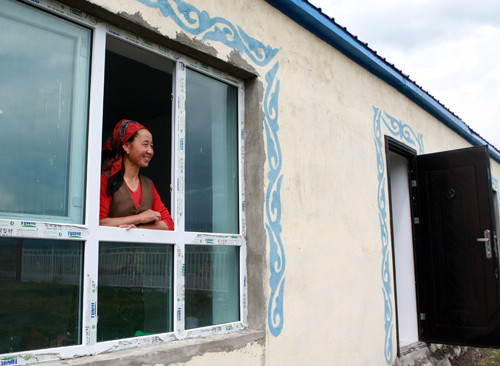|
 |
|
SWEET HOME: Panigul looks out from her new house in a community in Kaxiajiaer Township, Zhaosu County, which is built with aid funds for Xinjiang (JIANG XIAOYING) |
Panigul, a 33-year-old Kazak woman, used to live a nomadic life, moving from one pasture to another with her husband and two children. In April the family moved into their new permanent house in a settlement in Kaxiajiaer Township, Zhaosu County. The settlement now has 15 Kazak households. Panigul bought an 80-square-meter house and a 2,000-square-meter yard for 30,000 yuan. Her house is built in the traditional Kazak style with blue paintings on white walls. A clinic and a school are only 700 meters away from her home. Having 30 sheep and six cows, she built a shed in the yard.
"Before we moved in, my family rarely had fresh fruits and vegetable and were inaccessible to clean drink water. My kids couldn't go to school," Panigul said. "Now I can plant vegetables in my yard."
Adalate, Panigul and their fellow villagers are the direct beneficiaries of China's intensified efforts to aid Xinjiang's development.
On March 20, 2010, the Central Government finalized the details of a "pairing assistance" program for Xinjiang. According to the program, 19 provinces and municipalities in China's more prosperous eastern region have been assigned to assist the development of 19 prefectures and cities in Xinjiang through provision of personnel, technology, capital and management expertise.
The program focuses on helping people from different ethnic groups solve basic livelihood problems such as employment, education, housing and healthcare. Xinjiang is also encouraged to develop its strong industries such as agriculture, forestry, fruit growing and processing of agricultural produce.
Zhang Shaoyun, Deputy Director of the Development and Reform Commission of the Xinjiang Uygur Autonomous Region, said the region invested 5.3 billion yuan ($815.39 million) in 173 large pilot projects in agricultural development in 2010. He said more than half of the investment came from funds provided by aid partners, and 89 of the projects had been completed.
Zhang said the "pairing assistance" program will last at least 10 years. Between 2011 and 2015, the 19 aid providers plan to invest 66 billion yuan ($10.15 billion) in Xinjiang, 60 to 70 percent of which will be used in projects to improve local people's living standards.
This year, about 11.78 billion yuan ($1.81 billion) will be used on 1,234 projects, and 50 percent of these projects have already been launched. "These projects concern various fields such as agriculture, commerce, technological renovation, education, industry and urban planning, which will not only create job opportunities for local people, but will also provide training and improve the skills of local workers," Zhang said.
Xinjiang and the 19 aiding partners also established a channel to encourage state-owned and private enterprises from the wealthier provinces to invest in Xinjiang. "This is a good and complementary way for both sides to cooperate by integrating Xinjiang's rich natural and labor resources with the other province's capital, management and technological advantages," Zhang said.
As part of the "pairing assistance" program, the 19 eastern provinces and municipalities also dispatched outstanding officials to assume different-level government posts in Xinjiang. Coming from better-developed regions, these officials have not only brought Xinjiang more advanced management expertise, but also introduced investors to Xinjiang.
Sun Zhihong, Executive Vice County Mayor of Huocheng, is one of these officials. He and eight other officials were transferred from Jiangyin City, eastern Jiangsu Province, to Huocheng in October 2010. Their tenure in Xinjiang is three years.
"Our first mission was to conduct extensive investigations. We then devised development plans in accordance with Huocheng's current conditions," Sun said.
He said Jiangyin offered 1 billion yuan (about $153.85 million) to Huocheng in 2010 and it would set aside 0.3 to 0.5 percent of its annual GDP for aiding this Xinjiang county. Last year, Jiangsu provided Ili Kazak Autonomous Prefecture with 7.6 billion yuan ($1.17 billion) in aid.
On the basis of the development plans devised by officials from Jiangyin, Huocheng is building the Qingshuihe Development Zone near the Horgos Port, an important land crossing point toward Central Asia and Europe. The county has invested 2.5 billion yuan (about $384.62 million) in the project.
Huocheng conducted investment promotion road shows in Jiangsu in April and signed 12 program contracts with a combined value exceeding 1.81 billion yuan ($278.47 million).
"Enterprises have good reasons to invest here," Sun said. "They will benefit from ample natural resources, a big market and low labor costs."
Sun said he and the other eight officials from Jiangsu have acclimatized to their new northern environment. "At first we couldn't even stand the strong smell of mutton and beef in the local cuisine, but it doesn't disturb us nowadays. I have made friend with local people from various ethnic groups and I have learned a lot from them," he said.
"There is too much to do here," Sun said. "The transfer of skills and capital isn't like a temporary blood transfusion. By providing new capacities and infrastructure, we are revamping the region's entire circulatory system." | 